January 17-22: Santa Cruz, Cotoca and Samaipata
Bolivia is a hot destination for travelers looking for nature, culture and adventure and a paradise for backpackers. On my first visit, I only went to La Paz and Lake Titicaca. This time, I spent six weeks in this beautiful and extraordinary land-locked country. Introduction
Bolivia is a multiethnic country with a great variety of ethnic groups, terrains and climates. With an area of about 1,100,000km², it has soaring snow-cladded peaks of the Andes in the west to the Eastern Lowlands situated within the Amazon Basin. The country can be divided into three regions namely the Andean region (above 3000m), the sub-Andean region and the Llanos region (below 400m) occupying 28%, 13% and 59% of the national territory respectively.
Brief history
Advanced civilization which dates from as early as 1,500 BC existed around Tiwanaku. But importance of Tiwanaku declined around 1400 AD when food production in the area dried up. Between 1438 and 1537 AD the modern day Bolivia became part of the Inca Empire. Spanish conquistadors began to arrive in the 16th century and the Spanish conquest of the Inca Empire which began in 1524, was mostly completed in 1533. During the colonial period, the territory known as Upper Peru was under the administration of the Viceroy of Lima.
![bolimap2[1]](http://www.sarahontheroad.hk/wp-content/uploads/2014/03/bolimap21-300x262.gif) Struggle for freedom started in early 19th century and a republic named after Simón Bolívar, a leader in the Spanish American wars of independence, was established on August 4, 1825 with Antonio Jośe de Sucre serving as the second and third presidents. Attempt of president Andrés Santa Cruz to form a confederation with Peru failed.
Struggle for freedom started in early 19th century and a republic named after Simón Bolívar, a leader in the Spanish American wars of independence, was established on August 4, 1825 with Antonio Jośe de Sucre serving as the second and third presidents. Attempt of president Andrés Santa Cruz to form a confederation with Peru failed.
After independence, the republic has been struggling through periods of political instability and economic woes. Furthermore, it has lost over half of its territory to neighbouring countries. Chile took control of vast territories in southwestern part of the country rich in natural resources including the Pacific coast following the War of the Pacific (1879-83). Brazil seized the state of Acre known for its production of rubber in the Acre War in 1903. Bolivia fought the Chaco War (1932-1935) with Paraguay over a disputed territory which was mooted to have oilfields. In 1938, most of the disputed territory went to Paraguay.
National politics were dominated by caudillos up till 1880s. From 1890s to 1930s, the country was ruled by a civilian oligarchy. When the traditional political system failed, the military started to intervene until the 1952 Revolution under the leadership of Víctor Paz Estenssoro of the Revolutionary National Movement (MNR) Party. The MNR government remained in power for the next 12 years before being thrown away by a military junta.
Political instability, chaos, violence, social unrest and failed economic policies have hindered Bolivia’s social and economic developments. The economy was in a mess and inflation rate reached 35,000% annually in early 1980s. In 2005, Evo Morales of the Socialist Movement Party (MAS) became Bolivia’s first indigenous president.
Economy
Bolivia is a developing country. Its GDP nominal and GDP (PPP) (2012 estimate) are UD$27.4 and 55.3 billion respectively. The GDP (PPP) per capita is about US$5,100. Its main economic activities include agriculture, forestry, fishing, mining, manufacturing and petroleum refinery. Tourism has grown since 1990s. It is very wealthy in minerals including tin, natural gas (with second largest reserve in the continent) and lithium (estimated to have 5.4 million cubic tonnes representing 50%–70% of world reserves). The country’s gas reserves have been nationalised since 2005.
People and culture
Bolivia is a multiethnic country with approximately three dozen native groups including 2.5 million Quechuas, 2 million Aymaras, 180,000 Chiquitano and 125,000 Guaraní. Out of an estimated population of 10 million, Amerindian, Mestizo and White comprise 55%, 30% and 15% respectively. It has 38 official languages. About 78% of the population are Catholics and 19% Protestants.
Bolivia is rich in tourism resources given its cultural heritage and biodiversity. It has six World Heritage Sites including El Fuerte, six Jesuit Missions and Noel Kempff Mercado National Park (all in Santa Cruz Department), City of Potosi, the historic city of Surce and Tiwanaku.
January 17, Friday: Corumbá, Brazil – Quijarro, Bolivia (GMT – 4 hours) I had a terrible experience at the Brazil border as a result of inefficient and inadequate staffing situation at the check point. But I had no problem on the Bolivian side. There are only three counters by the roadside. I queued up for about five minutes, a lady took my passport, input the data efficiently and stamped my passport. I am impressed.
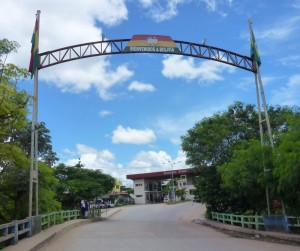 |
A young man offered to take me to the bus terminal for B$10. I found a money changer and got B$685 for US$100. I was dropped off at the bus station and brought a ticket for B$144 for a cama (a bed) bus leaving for Santa Cruz departing at 7:15pm. There is nothing to do in this small border town. I strolled around for half an hour. Then the sky darkened and gusty wind brought heavy rainfall for some 20 minutes. I took shelter in a small guest house. When the rain stopped, I was told to leave.
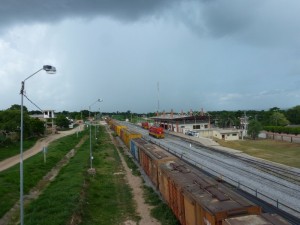 |
I then discovered the train station, the newest building in town with comfortable seats. It was empty as the train for Santa Cruz would be leaving at 6:30pm. I spent the whole afternoon finishing my notes on Bonito. Then the Ferriar family arrived and I saw them off at the station. I had a quick meal with chicken and rice and got on board the bus which left around 8pm. There was non-stop lightning and thunder for almost an hour. A spectacular show of the Mother Nature!
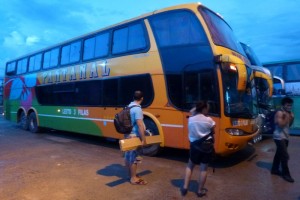 |
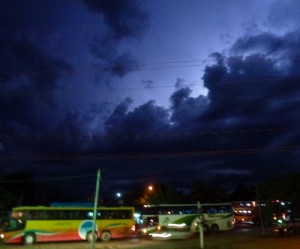 |
January 18 Saturday: Santa Cruz
Bolivia is divided into nine departments and Santa Cruz is the largest one. It capital city, Santa Cruz is also the most populous city with over 1.4 million population. 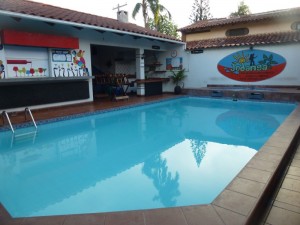 I arrived at the bus terminal at 5:30am. As I could not find a decent room near the terminal, I took a taxi to the Jodanga Backpackers Hostel mentioned in the Lonely Planet. The hostel located close to the Parque Urbano is the best YHA hostel I have seen in the continent. It has a swimming pool, spacious and cozy sitting room, a well-equipped kitchen and good Wi-Fi. I paid B$90 for a bed. Good value!
I arrived at the bus terminal at 5:30am. As I could not find a decent room near the terminal, I took a taxi to the Jodanga Backpackers Hostel mentioned in the Lonely Planet. The hostel located close to the Parque Urbano is the best YHA hostel I have seen in the continent. It has a swimming pool, spacious and cozy sitting room, a well-equipped kitchen and good Wi-Fi. I paid B$90 for a bed. Good value!
As I could not check in till 2pm, I spent four hours exploring the city on foot. I find the old city centre in a poor state: some roads are being paved, horrible smell came from the broken pipes and many colonial houses are falling apart. The city is vibrant but small with few attractions. I visited the Plaza 24 de Septiembre and a cathedral with a bell tower. A modern art museum next to the cathedral was closed. The few modern buildings in the city are ugly. I tried but failed to find a group tour to the Jesuit Missions. Two agencies asked me for US$1,600 for a private 4-day trip. Ridiculous!
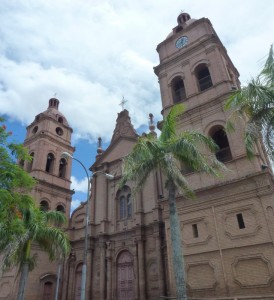 |
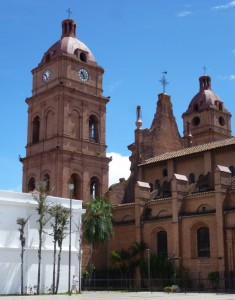 |
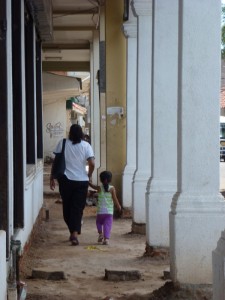 |
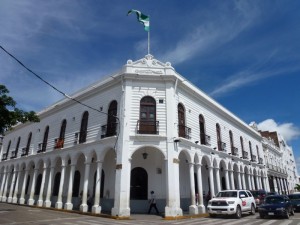 |
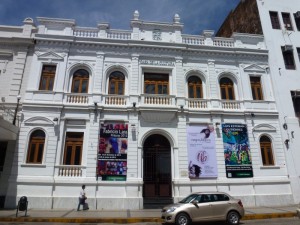 |
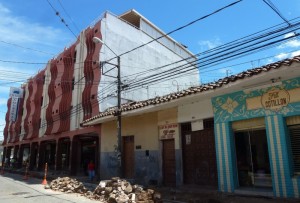 |
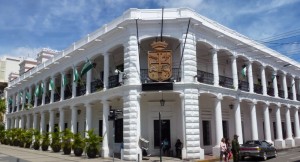 |
I spent the rest of the day in the hostel and went to bed early. I had a surprisingly sound sleep despite the music and talking coming from the pool side. January 19 Sunday: Santa Cruz- Cotoca – Sampaipata (160km) Cotoca is a small town located 18km from Santa Cruz. Locals make a trek to the church in order to leave an offering for Virgin of Cotoca around 7pm on December 8 every year. They believe she will answer their prayer. There is also a popular artisan Sunday market.
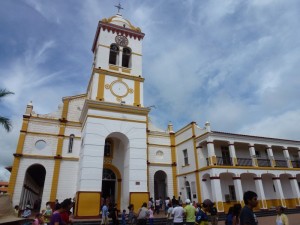 |
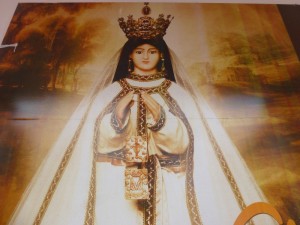 |
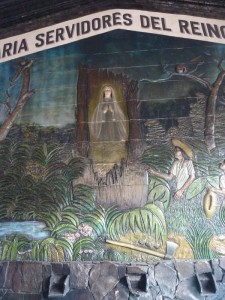 |
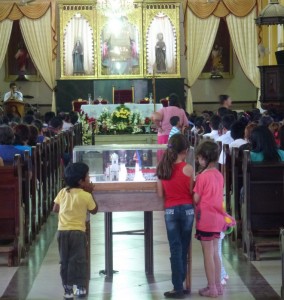 |
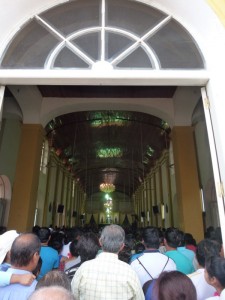 |
I decided to make a side trip for a few days. First, I took a taxi to Cotoca for B$70. The church was packed with Sunday mass church-goers. Some pilgrims were praying in the courtyard. A statute of Virgin of Cotoca is placed in the altar and another one at the back. The guard let me through a back door of the church and I saw the Virgin of Cotoca. The square was full of people with a band playing some music and artisans selling all sorts of souvenirs. I found in a huge cooked food centre next to the market. There were over 70 stalls selling ‘majadito’ (a chicken and rice dish) and many local dishes. I tasted two types of pastry and had a coffee.
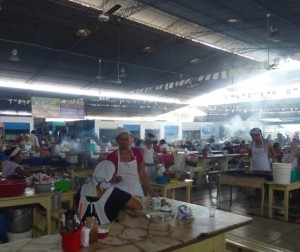 |
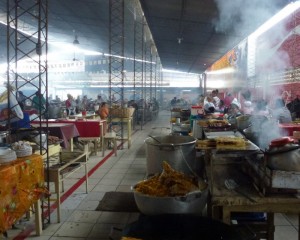 |
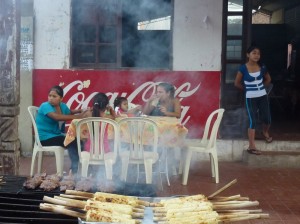 |
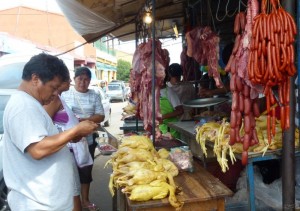 |
I took a shared taxi to Santa Cruz for only B$5! I was dropped off at a busy market near the city centre. I brought a large bunch of bananas for only B$10. The meat, sausages and chicken look fresh and fruits and vegetables are in abundance. I had to take a taxi to the other side of the city to catch a shared taxi to Samaipata, a village at the foothills of the Cordillera Oriental (about 120km west of Santa Cruz). The taxi had five passengers and each paid B$30 for a 3-hour journey.
I arrived in Samaipata (1650m) around 4pm. I had a single room with toilet at B&B Adorina for B$90. The place is run by Andreas, a Dutchman who has been living here for over 10 years. He takes volunteers to work in the hostel and his organic farm outside the village. Flippo, an Italian, is a volunteer who has just spent nine months in Argentina and arrived one day before me. He likes cooking and has become a chef in the hostel!
Samaipata is very small with few street, an old church, a lovely square and a Mercado. There are also a number of nice restaurants and cafés. I was hungry and had a set lunch for B$18 in a restaurant near the square. I became a frequent customer of Café 1900 which offers free Wi-Fi (though it does not always work). I got a glass of red wine for B$12 and spent two hours there! Before going back to the hostel, I went to the church and enjoyed the ambience.
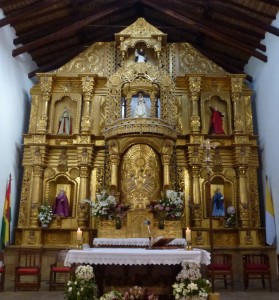 |
I like Samaipata on first sight. It is indeed a good base to explore the area. I ended up spending four nights in this lovely village.
January 20 Monday: Cloudy Forest hike (7km)
I got up at 6am and had a morning walk. After a healthy breakfast with fruit, jam and bread, I and three young Spanish travellers from the same hostel found a day trip offered by Chané Tours. When Saul, a French Canadian came along, we just had to pay B$130 each for a cloud forest hike at the Amboró Park.
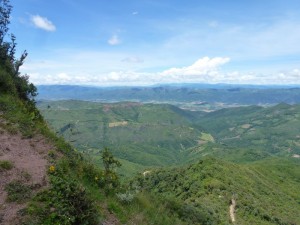 |
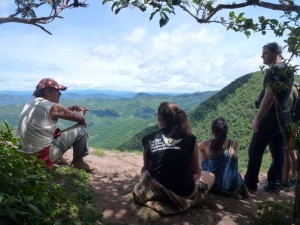 |
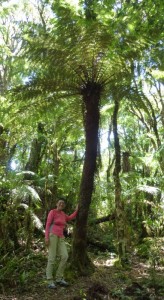 |
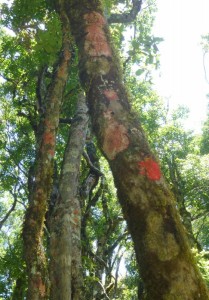 |
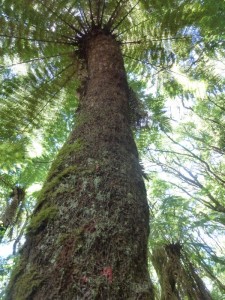 |
We saw numerous 200-600 years old fern trees in the cloud forest. The panoramic views when we reached the highest point at 2450m are fantastic. Mist came and went quickly. It was peaceful, green, quiet and without pollution. We arrived in Samaipata at 4pm.
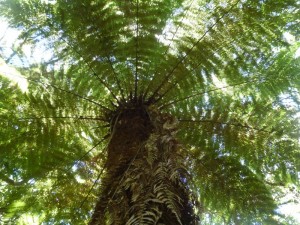 |
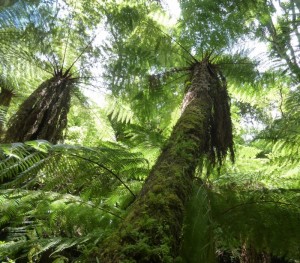 |
I was hungry and had a delicious late lunch-cum-dinner with grilled chicken and soup at Café 1900 for B$30. There is not much to do in the village. I returned to Café 1900 for a glass of wine in order to use the Wi-Fi. Then Julie, a German lady from the same hostel came in and joined me. We had a nice chat. She has been travelling with a girlfriend but was planning to make her own way to see the Amazon Basin. Her friend preferred to stay in Samaipata. Travelling with companions are great when it works. Otherwise, it is easier to travel solo.
January 21 Tuesday: Visit to El Fuerte
I wanted to take a condor hike. But Chané Tours only had a group departure the following day. So I made a trip on my own to El Fuerte, a mystical pre-Inca archaeological site. The entrance fee is B$50. I paid B$100 for a taxi. Hebort the driver is a nice guy and teaches me Spanish. I took a guide, Cecilio for B$75. He is ten years younger than me but looks like a 60-year-old man.
El Fuerte, a large sculpted rock with the highest point at 2000m, is thought to have been the ceremonial centre of a pre-Hispanic culture. From a viewing platform, I got the best view of the rock face- two round sculptures which are supposed to be a jaguar, a long snake’s back channeling and the round priest’s choir-loft in the centre. The south side of the rock contains the temple of sacristy, some Inca niches and many rows of seats and ladder platforms. There is also a big plaza with stone foundation of many Inca houses, a large Spanish house and a large structure (kallanka) which might be the administrative or military headquarters. On the north face, the rock is mostly barren with only five niches and a staircase which was supposed to be the entrance to the site.
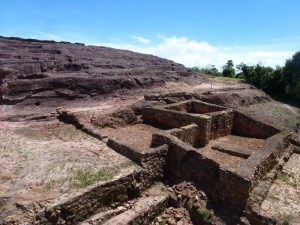 |
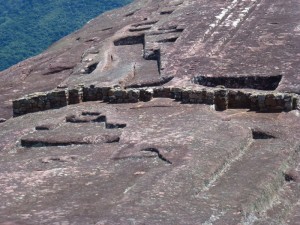 |
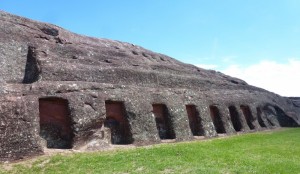 |
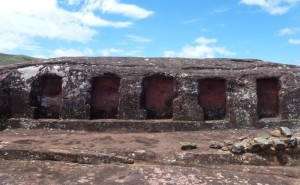 |
My guide told me that during the Inca time, some 400 men and 200 women (all single) were working here while their families would be living in Vallegrande some 100km away. There were only six visitors and I felt I had the whole place to myself.
After a siesta, I walked back to the museum in the village to learn more about El Fuerte. There is a short documentary on the excavation of the site by Bolivian archaeologists who traced the location based on history and information written by the Spanish. There are a few items mainly ceramic pots on display, some of which are 3,500 years old. I walked back to Café 1900 for lunch. But the daily special had gone and there was no food left. I therefore walked to the market and got half a chicken for B$16 and some vegetables for B$5.
While I was cooking, I learnt Flippo would be preparing risotto for dinner for B$20 including wine. Though I had my chicken soup with plenty of vegetables, I joined the dinner for fun. Saul, two brothers from the US, Julie, a guy from Peru and his girlfriend from France, two Belgians and Flippo finished eight bottles of red wine that evening. Luckily wine is cheap: B$25 a bottle for a fairly nice wine. Great value for money!
January 22 Wednesday: Condor Hike (6km)
I set off with Ive, the owner of Chané Tours at 8am with four other hikers (two German ladies, an elderly Frenchman and a young Brazilian guy). It took us two hours to reach the starting point and the dirt road was bumpy. The scenery is awesome: the mountains, streams and lush vegetation are natural, beautiful and undisturbed.
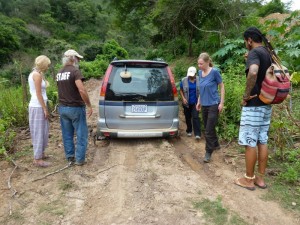 |
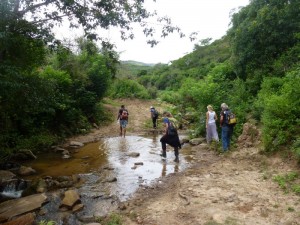 |
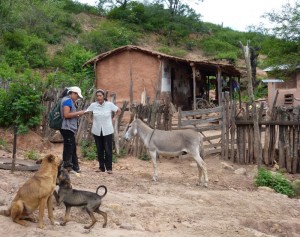 |
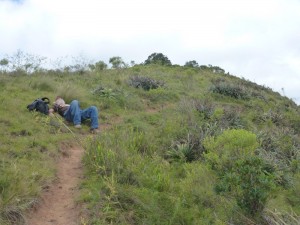 |
Ive is an excellent guide. Being a female, she is also more attentive. She is aware that the Frenchman who is about 70 years old, is not fit. He was panting and tired. I noted he walked unsteadily and worried he might fall. I walked behind him but could do nothing when he fell twice in front of me. Fortunately, he only cut his arms without twisting his ankles. (I fear I might be like him ten years later!)
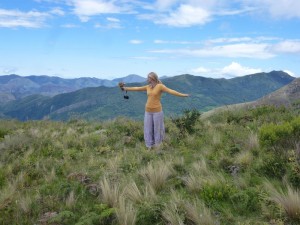 |
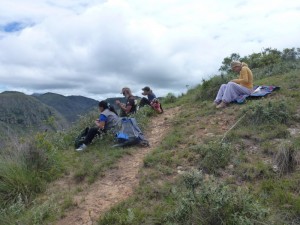 |
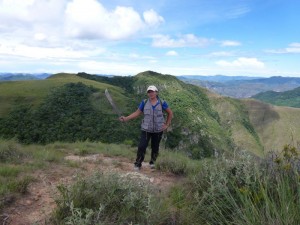 |
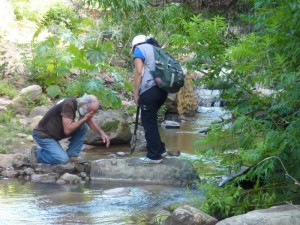 |
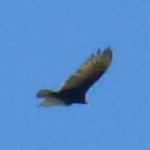 |
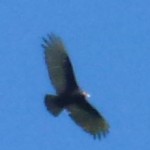 |
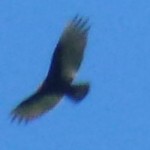 |
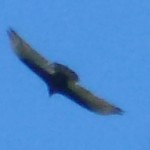 |
We had a fantastic day and saw a dozen of majestic condors gliding effortlessly across the sky. (I took pictures with my automatic camera as my SLR’s filter was broken. The photos are blur but I post them here for memory sake).
On the way back, we stopped at a waterfall. It was 7pm when I got back to the hostel. I paid B$200 for the trip (i.e. about US$30) and the satisfaction level is 150%! Flippo prepared a pasta with tuna and I had a good dinner again.
Lovely and peaceful Samaipata
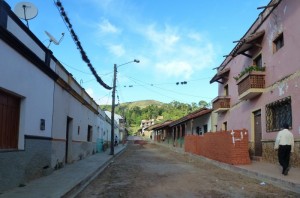 |
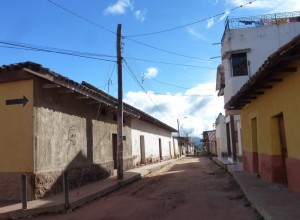 |
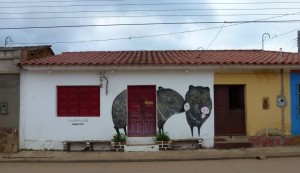 |
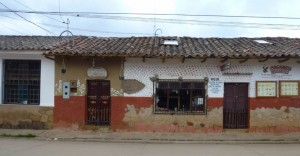 |
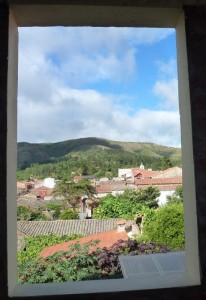 |
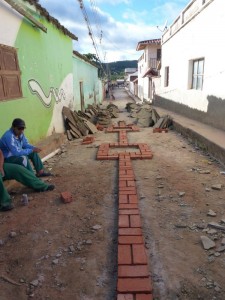 |


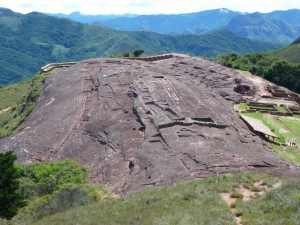
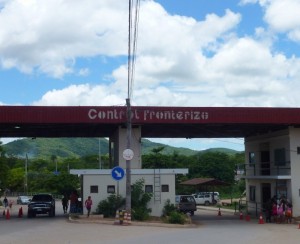
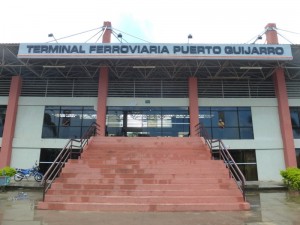
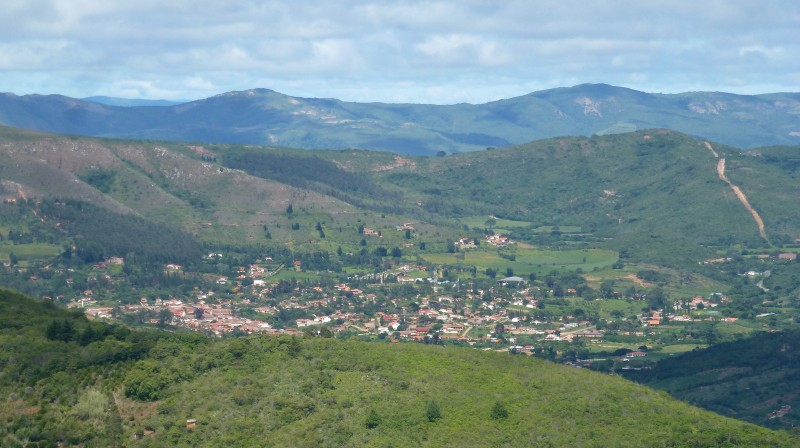
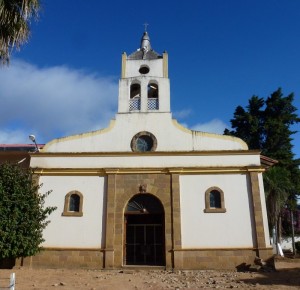
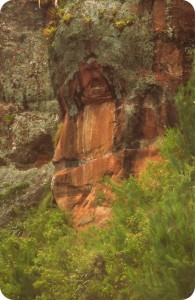
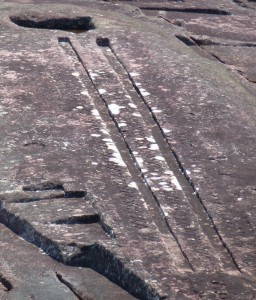
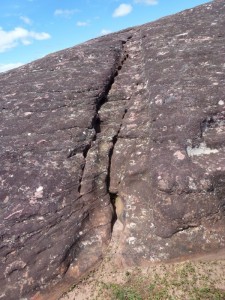
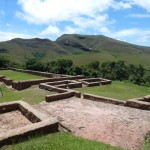
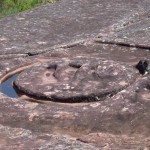
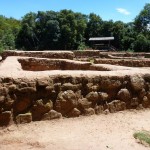
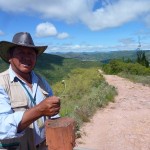
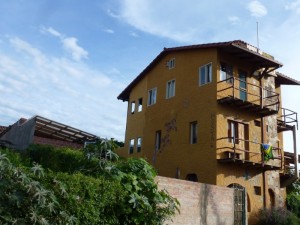
oh, sarah, you are now in Bolivia, so great,
have you go to the “MIRROR LAKE”???
take more beautiful picture ar
Take Care and Happy new year^^